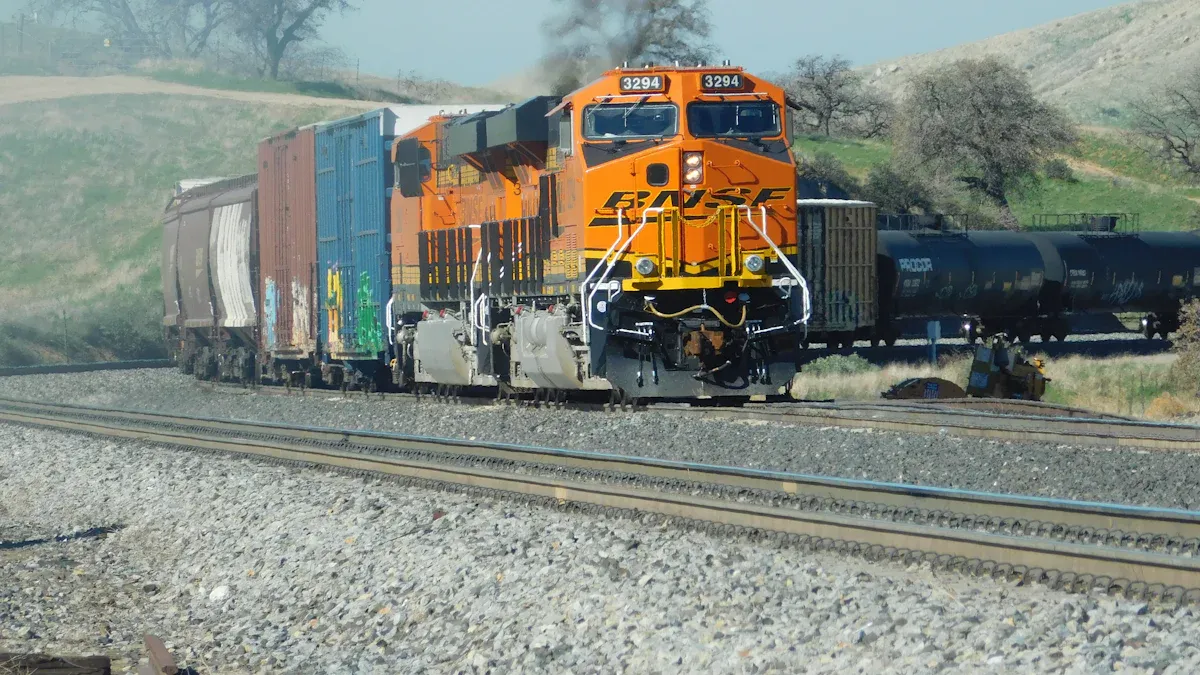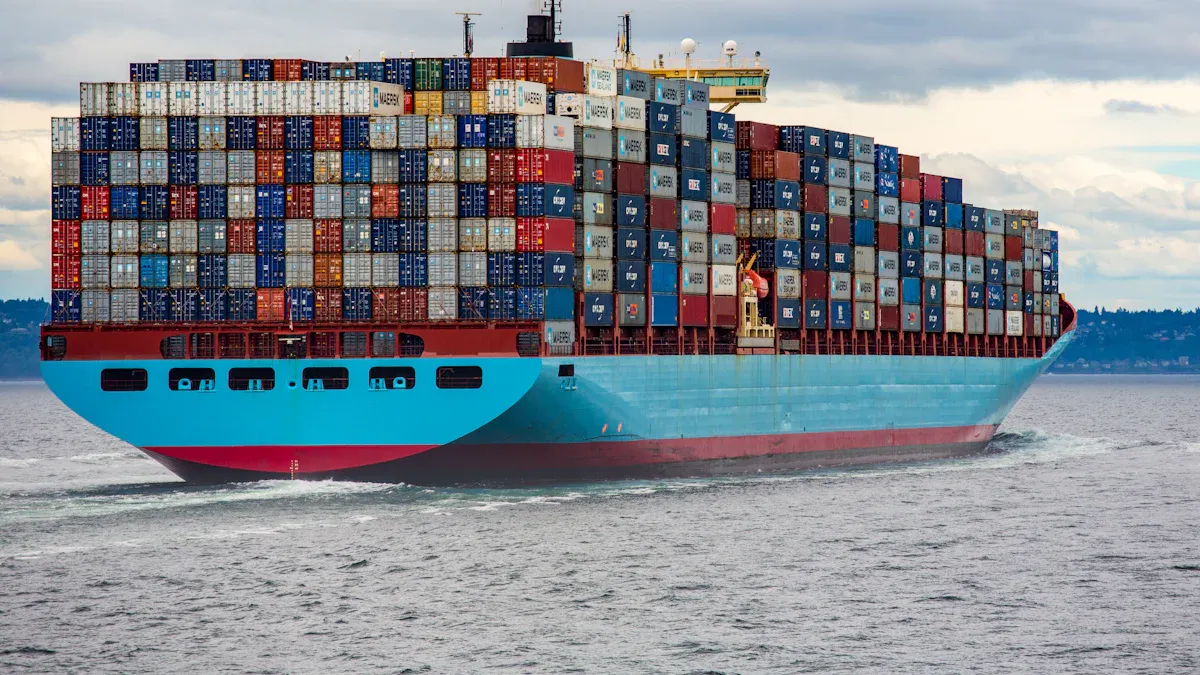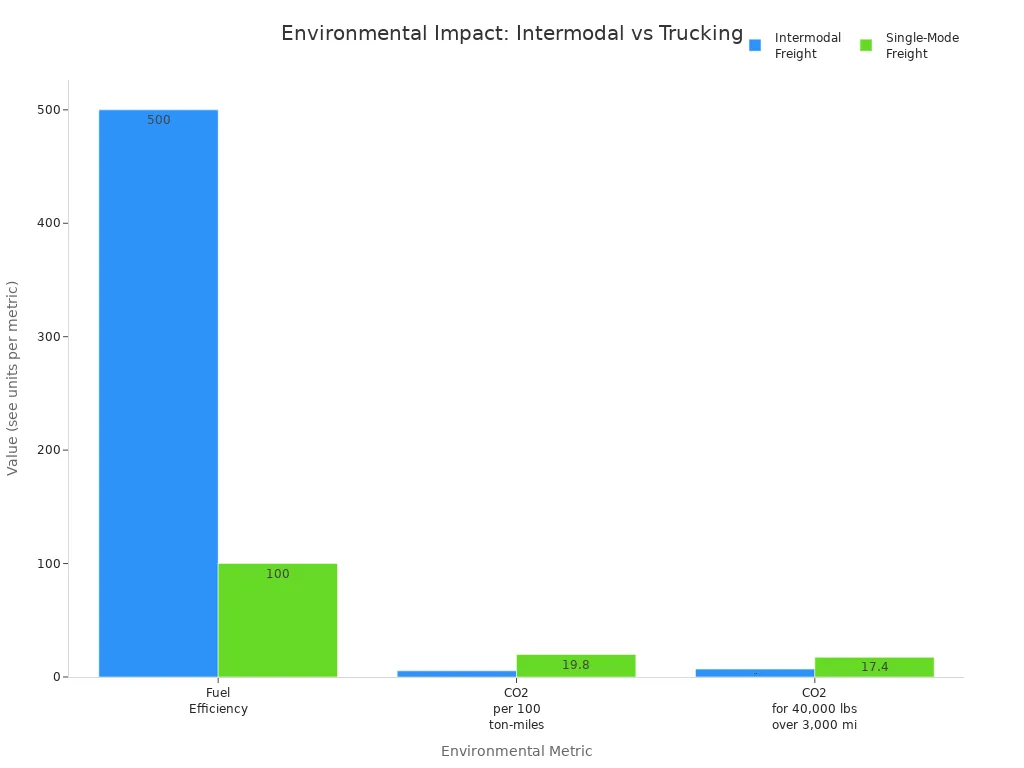Main Difference between Intermodal and Single-mode Freight

The main difference between intermodal and single-mode freight lies in the use of multiple transportation modes versus a single mode to move goods. This distinction shapes logistics strategies because intermodal shipping often reduces costs for long-haul routes, increases flexibility, and supports sustainability goals.
Businesses see lower freight costs and improved efficiency when they combine road and rail, as shown in the table below.
Aspect | Impact on Logistics Costs and Efficiency |
|---|---|
Intermodal combines truck flexibility with rail cost-efficiency for long hauls. | |
Intermodal offers a lower carbon footprint than single-mode road transport. | |
Real-time tracking and automation reduce operational costs and improve efficiency. |
Key Takeaways
Intermodal freight uses multiple transportation modes with sealed containers, reducing handling and damage risk, while single-mode freight uses one mode with simpler management.
Intermodal shipping saves costs on long-distance routes, lowers carbon emissions, and offers flexible routing, making it ideal for large, regular shipments.
Single-mode freight provides faster, direct delivery for short distances or urgent shipments, with easier contract management and fewer transfer points.
Intermodal freight requires careful coordination among carriers and may face delays, but advanced tracking and technology improve efficiency and visibility.
Choosing the right freight method depends on shipment size, distance, speed needs, and environmental goals to balance cost, flexibility, and simplicity.
Main Difference

Container Use
The main difference between intermodal and single-mode freight starts with how each method uses containers. Intermodal freight moves cargo in a sealed shipping container that stays with the goods from start to finish, even when the shipment changes from truck to train or ship. This approach keeps the cargo secure, reduces the risk of damage, and lowers labor costs because workers do not need to unpack and repack the goods at each transfer point. The container remains standardized and continuous across all modes of transport. In contrast, single-mode freight uses only one type of transport, such as a truck or a train, and does not require the container to move between different modes. The cargo may be loaded and unloaded more often, which can increase handling and the chance of damage. This operational difference in container use is a key part of the main difference between these two freight methods.
Contracts and Carriers
Another main difference appears in the way contracts and carriers are managed. Intermodal freight usually involves multiple contracts, one for each carrier or mode of transport. This structure gives shippers more flexibility to choose the best route or carrier for each leg of the journey, but it also adds complexity to logistics management. Each mode may require a separate bill of lading, and shippers must coordinate between different companies. Single-mode freight, on the other hand, typically uses a single contract with one carrier for the entire shipment. This makes contract management simpler and reduces the need for coordination. The table below highlights these differences:
Factor | Intermodal Transport | Single-Mode Freight |
|---|---|---|
Number of Contracts | Multiple contracts with different carriers | Single contract with one carrier |
Contract Complexity | Higher complexity | Simplified structure |
Bill of Lading | Separate for each mode | Single for entire shipment |
Flexibility | High flexibility in route/carrier choice | Less flexibility |
Logistics Coordination | Requires coordination among carriers | Streamlined by one carrier |
Handling and Transfers
Handling and transfers also show a clear main difference between these freight options. Intermodal shipping is designed to keep handling to a minimum. The sealed container moves from one mode to another—such as from a truck to a train—without opening or repacking the cargo. This reduces the risk of loss or damage and saves time and money. In single-mode freight, cargo may be handled more frequently, especially if it needs to be transferred between vehicles or facilities within the same mode. More handling can lead to higher labor costs and a greater chance of damage.
Intermodal systems use a unified transport unit to minimize handling, while single-mode shipping often involves more frequent cargo handling at transfer points.
Environmental Impact and Management Simplicity
The main difference between these freight methods also affects the environment and management. Intermodal freight, especially when it uses rail, offers much better fuel efficiency and lower carbon emissions than single-mode trucking. For example, one intermodal train can move a ton of freight nearly 500 miles on a single gallon of fuel and can replace about 280 trucks on the road. This leads to a 60-65% reduction in carbon emissions compared to trucking alone. The chart below shows how intermodal and single-mode freight compare in fuel efficiency and CO2 emissions:

Intermodal freight reduces harmful emissions and fuel use by combining rail and truck.
Rail is 75% more fuel-efficient than trucks, lowering greenhouse gases.
Fewer trucks on highways mean less congestion and better air quality.
Intermodal shipments produce about 60% less carbon emissions than trucking alone.
However, intermodal freight comes with more management challenges. Shippers must deal with different protocols, possible delays, and the need for specialized terminals. Regulatory rules can also vary between modes. Single-mode freight is simpler to manage, with fewer transfer points and less regulatory complexity, but it does not offer the same cost or environmental benefits.
The main difference between intermodal and single-mode freight shapes how companies handle logistics, costs, and sustainability. Intermodal offers flexibility and environmental advantages, while single-mode provides simplicity and easier management.
Definitions
Intermodal Freight
Intermodal freight means moving goods in containers that travel across different types of transportation, such as trucks, trains, and ships. Logistics organizations agree on several key points about intermodal freight:
Goods stay inside the same container from the starting point to the final destination.
Containers follow ISO standards, so they fit on trucks, trains, and ships without needing to be unpacked.
Each part of the journey may use a different carrier, and shippers often sign separate contracts for each mode.
Transfers happen at special terminals, like seaports or inland hubs, where containers move between vehicles but the cargo inside does not get handled.
This method reduces the risk of damage, saves time, and lowers costs.
Intermodal freight also helps the environment by cutting down on fuel use and emissions.
Companies invest heavily in infrastructure, such as cranes and terminals, to support these operations.
Many experts expect intermodal freight to grow because it offers cost savings and flexibility.
Intermodal freight stands out because it uses standardized containers and keeps cargo handling to a minimum during transfers. This process makes shipping safer and more efficient, especially over long distances.
Single-mode Freight
Single-mode freight uses only one type of transportation for the entire trip. The most common examples include shipping goods by truck, rail, air, or sea, but never switching between these modes. Logistics experts highlight several features of single-mode freight:
One carrier manages the shipment from start to finish.
Shippers sign a single contract for the whole journey.
The process is simple, with fewer steps and less paperwork.
There is no need to transfer containers between different types of vehicles.
Handling may happen more often, especially if goods move between trucks or railcars within the same mode.
Single-mode freight offers a straightforward solution for short distances or when only one type of transport is available. It reduces complexity but may not provide the same cost or environmental benefits as intermodal freight.
How It Works

Intermodal Process
Intermodal freight uses a step-by-step process that combines different transportation modes. This method keeps the cargo inside a single container from start to finish. The process involves several key steps:
Origin Pickup: A drayage carrier picks up an empty container and delivers it to the shipper. The shipper loads the freight, secures it, and seals the container.
Drayage to Terminal: The loaded container moves by truck to an intermodal terminal.
Terminal Operations: Specialized equipment transfers the container onto a train or ship. Workers do not open the container during this step.
Long-Haul Transportation: The container travels long distances by rail or ocean vessel. This step connects major hubs across regions or countries.
Arrival at Destination Terminal: The container arrives at a terminal near the final destination. Workers transfer it back onto a truck.
Last-Mile Delivery: The truck delivers the sealed container to the consignee’s location.
Documentation and Tracking: Throughout the journey, shippers manage paperwork like bills of lading and customs forms. Real-time tracking systems provide updates on the shipment’s status.
Intermodal shipping requires careful coordination at each step. Shippers must manage schedules, equipment handoffs, and documentation across multiple carriers. Advanced tracking and transportation management systems help keep the process smooth and efficient.
Single-mode Process
Single-mode freight uses only one type of transportation, such as truck, rail, or ship, for the entire journey. This process is much simpler than intermodal shipping.
One carrier handles the shipment from pickup to delivery.
The shipper loads the freight onto the vehicle at the origin.
The same vehicle or carrier moves the freight directly to the destination.
Fewer handoffs mean less risk of delay or damage.
Tracking is straightforward because only one company manages the shipment.
Paperwork and coordination are minimal.
Single-mode freight offers a streamlined process with fewer steps and less complexity. This makes it easier to manage but less flexible than intermodal shipping.
Comparison
Cost
Intermodal freight often provides lower costs for long-distance shipments. Rail transport uses less fuel than trucks, making it more efficient for routes over 500 miles. The table below shows how costs compare:
Factor/Condition | Intermodal Freight (Rail + Drayage) | Single-Mode Truckload Freight |
|---|---|---|
Typical Distance for Cost Savings | 500+ miles (optimal 700+ miles) | Preferred for shorter distances (<500 miles) |
Cost Efficiency | Lower cost due to rail fuel efficiency over long distances | Generally higher cost for long hauls |
Fuel Price Impact | More cost-effective when fuel prices are high | Less fuel-efficient, cost rises with fuel prices |
Accessorial Charges | Possible extra fees (detention, demurrage, per diem) | Fewer accessorials but higher base cost |
Intermodal shipments include drayage, rail linehaul, and fuel costs. Truckload freight works best for short, urgent, or fragile shipments. Extra fees can increase intermodal costs if not managed.
Speed
Intermodal freight can deliver faster than single-mode sea or rail alone by combining modes. For example, a shipment may travel by ship and then switch to rail for quicker delivery. Intermodal logistics use the strengths of each mode to improve delivery times, but transfers between modes can cause delays. Single-mode freight, such as air or dedicated truck, offers the fastest transit for urgent shipments but at a higher cost.
Flexibility
Intermodal freight stands out for its adaptability. It can switch between rail, truck, or ship if disruptions occur. Digital tools and AI help plan alternate routes, keeping goods moving during unexpected events. Single-mode freight only adjusts routes within the same mode, so it cannot change to another type of transport if problems arise.
Environmental Impact
Intermodal freight, especially when using rail, reduces fuel use and emissions. Rail is more fuel-efficient than trucks, which lowers greenhouse gases. Fewer trucks on highways also mean less congestion and better air quality. Single-mode trucking creates more emissions and uses more fuel per mile.
Risk
Intermodal shipments face more complex risks. Multiple modes and transfers increase the chance of damage or loss. Risks include equipment failures, natural disasters, and regulatory changes. Containers may shift during rail transport, and damage might not be found until delivery. Single-mode freight has fewer transitions and more direct handling, which lowers some risks. However, both methods require careful packaging and monitoring to protect goods.
Pros and Cons
Intermodal
Intermodal freight offers many advantages for businesses that ship goods over long distances. Logistics professionals report that companies can save up to 40% on shipping costs by using intermodal for long hauls. This method allows for flexible routing, which helps avoid traffic and reduce delays. Containers stay sealed during the journey, improving cargo security and lowering the risk of theft or damage. Intermodal shipping also supports environmental goals by using fuel-efficient rail transport, which reduces emissions and highway congestion. Technology, such as real-time tracking and automated systems, gives shippers better control and visibility over their shipments. Intermodal also helps companies handle busy seasons by providing reliable and scalable service.
Key advantages of intermodal freight:
Cost savings for long-distance shipments
Flexible and optimized routing options
Reduced congestion and faster transit times
Improved cargo security with sealed containers
Environmental benefits from fuel efficiency
Reliable and scalable for peak demand
Enhanced shipment visibility with real-time tracking
However, intermodal freight has some drawbacks. Delays can happen due to rail network issues or weather. Tracking shipments may be difficult, especially for imports. Shippers must manage multiple contracts and coordinate with several providers, which adds complexity. Unexpected charges, such as detention or drayage fees, can increase costs. Intermodal is less flexible for rural areas without rail access and may not suit urgent or time-sensitive deliveries.
Intermodal freight works best for long hauls and high-volume shipments but requires careful planning and coordination.
Single-mode
Single-mode freight provides a simple and direct shipping solution. One carrier manages the shipment from start to finish, making the process easy to track and control. This method works well for short distances or when only one type of transport is available. Road transport offers door-to-door delivery and quick transit for local shipments. Rail is cost-effective for large loads over long distances.
Main advantages of single-mode freight:
Simple management with one carrier and contract
Direct routes with fewer handoffs
Fast delivery for short distances
Single-mode freight also has limitations. Full truckload shipping can be expensive for small shipments, and truck availability may drop during busy seasons. Less-than-truckload shipping is more flexible but involves more handling, which can cause delays or damage. Road transport faces delays from traffic and weather, and it is less efficient for long or international routes. Rail and air transport have fixed schedules and limited coverage, reducing flexibility.
Advantage | Limitation |
|---|---|
Simple process | Higher costs for small shipments |
Direct delivery | Less flexible for long distances |
Fewer handoffs | Delays from traffic or weather |
Single-mode freight suits short, direct shipments but may not offer the cost or flexibility benefits of intermodal for complex or long-distance needs.
Choosing
Factors
Businesses must consider several important factors when deciding between intermodal and single-mode freight. Each factor can affect cost, efficiency, and reliability.
Cost: Intermodal shipping often saves money on long hauls, especially over 500 miles. Companies can use existing infrastructure to lower capital and maintenance expenses. However, drayage costs and extra handling may add to the total price.
Transit Time: Trucking usually provides faster delivery and fewer handling points. When speed and consistency matter most, single-mode trucking may be the better choice.
Shipment Volume and Size: Rail and intermodal work best for large, regular shipments. Trucking suits smaller or spot shipments that do not fill a full container.
Cargo Type and Value: Intermodal fits intermediate-value goods and loads up to 25 tons. High-value or fragile items may need special handling or direct routes.
Distance: Intermodal is ideal for shipments traveling more than 300 miles. Single-mode works well for short, direct routes.
Flexibility and Resilience: Intermodal offers flexibility by using different modes, which helps during disruptions like weather or strikes. Trucking provides more adaptable routes but may face road delays.
Technology: Advanced systems like GPS tracking, TMS, and EDI help manage complex intermodal shipments and improve visibility.
Regulations: Rules about driver hours, equipment, and weight can impact both modes. Regulatory differences may make single-mode simpler in some regions.
Provider Experience: Companies should choose carriers with strong reputations and experience in handling their type of freight.
Companies that match their shipping needs to these factors can improve efficiency and control costs.
Best Uses
Intermodal and single-mode freight each have situations where they work best. The right choice depends on shipment details and business goals.
Freight Method | Best For |
|---|---|
Intermodal | - Shipments over 500 miles |
Single-mode | - Full truckload shipments (over 15,000 pounds) |
Intermodal shipping suits businesses moving large volumes over long distances, especially when cost and sustainability matter. Single-mode freight fits urgent, high-value, or direct shipments where speed and control are top priorities. Companies should review their shipment size, distance, cargo type, and service needs before choosing the best method.
The main difference between intermodal and single-mode freight shapes every shipping strategy. Intermodal uses multiple modes for greater flexibility, efficiency, and lower emissions, while single-mode offers simplicity and direct routes. The table below highlights how each method impacts cost, speed, and environmental goals:
Factor | Intermodal Freight | Single-Mode Freight |
|---|---|---|
Flexibility | High | Moderate |
Cost Savings | Strong for long hauls | Best for short trips |
Emissions | Lower | Higher |
Businesses should match their freight method to operational needs. This approach helps control costs, reduce risks, and support sustainability. For more insights, logistics professionals can explore transportation management systems or consult with experienced carriers.
FAQ
What is the main benefit of intermodal freight?
Intermodal freight helps companies save money on long-distance shipments. It uses trains and trucks together. This method also lowers carbon emissions. Many businesses choose intermodal to move large loads efficiently.
When should a business use single-mode freight?
A business should use single-mode freight for short trips or urgent deliveries. This method works best when speed matters. It also helps when only one type of transport is available.
Does intermodal shipping take longer than single-mode?
Intermodal shipping can take more time because containers switch between trains and trucks. Transfers may cause delays. Single-mode freight often delivers faster for short distances.
Is intermodal freight safer for goods?
Yes, intermodal freight keeps goods in sealed containers. Workers do not open the containers during transfers. This process reduces the risk of damage or theft.
Can small shipments use intermodal freight?
Most intermodal services work best for large shipments. Small loads may not fill a container. Some companies offer shared container options, but single-mode freight often suits small shipments better.
See Also
In-Depth Insights Into The Future Of LTL Freight
Discover The Latest Trends In Sea Freight Logistics 2024
Preparing For New Transport Technologies Transforming Supply Chains
How Innovations Are Changing The Landscape Of Logistics
Comprehensive Guide To Eco-Friendly Transportation In Supply Chains
